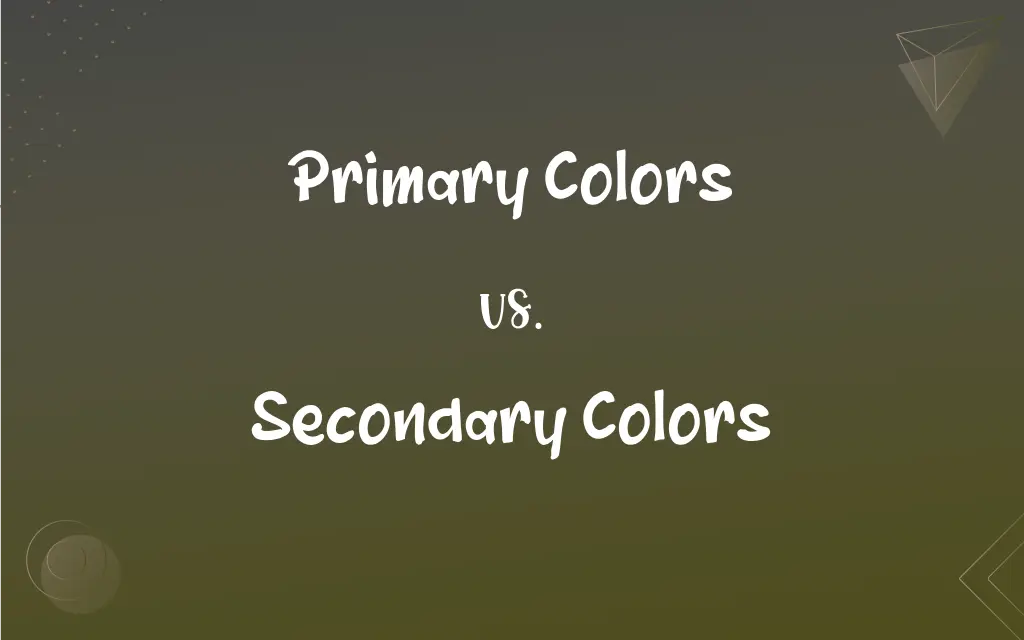Primary Colors vs. Secondary Colors: What's the Difference?
Edited by Aimie Carlson || By Harlon Moss || Published on February 29, 2024
Primary colors (red, yellow, blue) are foundational colors that cannot be created by mixing others, while secondary colors (green, orange, purple) are formed by mixing primary colors.

Key Differences
Primary colors, consisting of red, yellow, and blue in traditional color theory, are the basic colors from which all other colors derive. Secondary colors, namely green, orange, and purple, are created by mixing equal parts of two primary colors.
In the realm of primary colors, no combination of colors can create these fundamental hues. Conversely, secondary colors are the direct result of combining primary colors; for instance, mixing red and yellow yields orange.
Primary colors serve as the starting point for creating a broad spectrum of hues in color theory. In contrast, secondary colors offer a rich palette that enhances the diversity of color combinations, enriching artistic and design possibilities.
The concept of primary colors is crucial in understanding color relationships and color mixing. On the other hand, secondary colors demonstrate the practical application of color theory, showcasing how new colors emerge from primary ones.
When it comes to visual arts and design, primary colors are often used for their bold and pure qualities. Secondary colors, however, are frequently employed to create depth, contrast, and harmony in compositions.
ADVERTISEMENT
Comparison Chart
Basic Definition
Foundational colors
Created by mixing primary colors
Colors Included
Red, yellow, blue
Green, orange, purple
Creation Method
Cannot be created by mixing
Formed by mixing two primary colors
Role in Color Theory
Starting point for color spectrum
Enhance diversity of color combinations
Usage in Art and Design
Used for boldness and purity
Employed for depth and harmony
ADVERTISEMENT
Primary Colors and Secondary Colors Definitions
Primary Colors
Primary colors cannot be created by mixing other colors.
To get a wide range of hues, start with the primary colors.
Secondary Colors
Secondary colors are formed by mixing two primary colors.
I mixed blue and yellow to get a perfect green, a secondary color.
Primary Colors
Primary colors are the base colors in color theory.
The artist used primary colors to create a vibrant palette.
Secondary Colors
They demonstrate practical color theory application.
In our art class, we learned to make secondary colors from primary ones.
Primary Colors
They are fundamental to understanding color relationships.
Learning about primary colors is essential in color theory education.
Secondary Colors
Secondary colors are crucial for creating contrast and harmony in art.
I often use secondary colors to create a sense of balance in my designs.
Primary Colors
Primary colors are key in art and design for creating diverse hues.
By mixing primary colors, you can achieve almost any color you need.
Secondary Colors
They include green, orange, and purple.
The secondary colors, like green and purple, add depth to my painting.
Primary Colors
They include red, yellow, and blue.
Primary colors like red, yellow, and blue are basics in any painter's toolkit.
Secondary Colors
Secondary colors enhance the color palette derived from primary colors.
Using secondary colors, I created a more complex and harmonious color scheme.
FAQs
What are primary colors?
Basic colors in color theory: red, yellow, and blue.
How are secondary colors created?
By mixing equal parts of two primary colors.
What colors make green?
Mixing blue and yellow, both primary colors.
What are secondary colors?
Colors formed by mixing two primary colors: green, orange, and purple.
Can primary colors be made by mixing other colors?
No, they are fundamental colors that cannot be created by mixing.
What combination produces purple?
Purple is made by mixing red and blue.
How do you get orange?
By mixing red and yellow, which are primary colors.
Are primary colors the same in all color systems?
No, they differ in additive (light-based) and subtractive (pigment-based) systems.
Do secondary colors have symbolic meanings?
Yes, like all colors, they can carry various cultural and emotional associations.
What is the role of secondary colors in design?
They add depth, contrast, and harmony to designs.
Why are primary colors important in art?
They are the foundation for creating a wide range of colors.
How do primary colors interact with light?
In light (additive color), primary colors are red, green, and blue.
Are primary colors more vibrant than secondary?
Typically, primary colors are bolder and more pure in hue.
Do secondary colors vary in shade depending on the mix?
Yes, the shade can vary based on the proportions of primary colors mixed.
Are primary or secondary colors used more in branding?
Both are used, depending on the desired emotional and visual impact.
Can secondary colors be mixed to form other colors?
Yes, mixing secondary colors can create tertiary colors.
Can secondary colors be primary in other systems?
In additive color systems, green, a secondary color in pigment, is primary.
Is it possible to mix all primary colors together?
Yes, but it usually results in a muddy or neutral color.
What happens when you mix all secondary colors?
Mixing all secondary colors can lead to a loss of vibrancy and a duller hue.
Can understanding primary and secondary colors improve photography?
Yes, it helps in creating visually appealing and balanced compositions.
About Author
Written by
Harlon MossHarlon is a seasoned quality moderator and accomplished content writer for Difference Wiki. An alumnus of the prestigious University of California, he earned his degree in Computer Science. Leveraging his academic background, Harlon brings a meticulous and informed perspective to his work, ensuring content accuracy and excellence.
Edited by
Aimie CarlsonAimie Carlson, holding a master's degree in English literature, is a fervent English language enthusiast. She lends her writing talents to Difference Wiki, a prominent website that specializes in comparisons, offering readers insightful analyses that both captivate and inform.































































